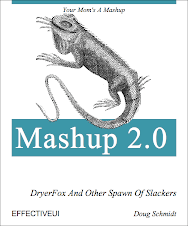I've had my MacBook Pro since late December (Merry Christmas), and I ordered it with 2GB of RAM, thinking that would be enough. And it was, for a while.
Virtually Home Free



However, I'm now at a 4-week gig where I need to be running Windoze. I have a 20 GB Boot Camp partition running WinXP. I have both Parallels Desktop (paid for) and VMWare Fusion (beta) installed, and both allow me to run a virtual machine using my Boot Camp partition. I've configured my VM to use 1GB of RAM for Windows, leaving the rest for OS X to do its stuff.
So now I can either boot direct to Windows and get the full power of my MacBook to run Windows, or I can run Windows-in-a-window using one of my virtualization tools.
The problem is that running the 1GB VM on a 2GB Mac just ends up bogging down OS X to the point where I can't run anything else. Not Firefox, not Entourage, nottin'!
Solution - Just add money!
So I decided to max-out my MacBook's RAM, swapping out one of the two 1GB SODIMMs for a 2GB SODIMM, giving me a total of 3GB.
I ordered from CanadaRAM.com. They had a great price for a 2GB module ($299 Cdn) and they shipped overnight. With shipping and taxes, everything came to about $360 Cdn. I had other Mac stores in town quoting me between $600 and $800 (before taxes), but I've had good experiences with CanadaRAM before.
Wow. What a difference that extra 1GB makes. OS X is back to its old snappy self when running a Windows VM. All the Dock effects, Expose, and Dashboard apps make lovely smooth transitions, and the OS is no longer paging to disk like crazy.
Right now, I'm running my Windows VM, plus OS X is running Entourage, Excel, Flex Builder 2, Firefox, ecto, and Acrobat Reader. Everything is happy-n-snappy.
Plus I should be able to resell the extra 1GB SODIMM for about $150 on craigslist, making the deal even sweeter!
Which VM tool to run?
I had previously been running Parallels Workstation on my PC, so I bought Parallels Desktop when I got my Mac, so that I could reuse the same VMs on either host platform. When VMware announced their Fusion product for Mac, I just let it go and kept using Parallels. But my experience with later versions of Parallels has seen quite a large slow down. VMs just didn't seem snappy, no matter what the configuration was.
So I installed the Fusion beta and gave it a try. It is great so far. The biggest advantage so far over Parallels is that Fusion will present 2 virtual CPUs to the guest OS, letting my Windows VM take full advantage of any unused cycles.
As part of the Fusion beta tester agreement, I'm not allowed to post any public claims about the performance of the product. I don't want to violate that agreement. But I am running VMware Fusion exclusively now, so I'll let you draw your own conclusions. :-)
Technorati Tags: Boot Camp, OS X, VMware Fusion, Parallels Desktop, virtualization












